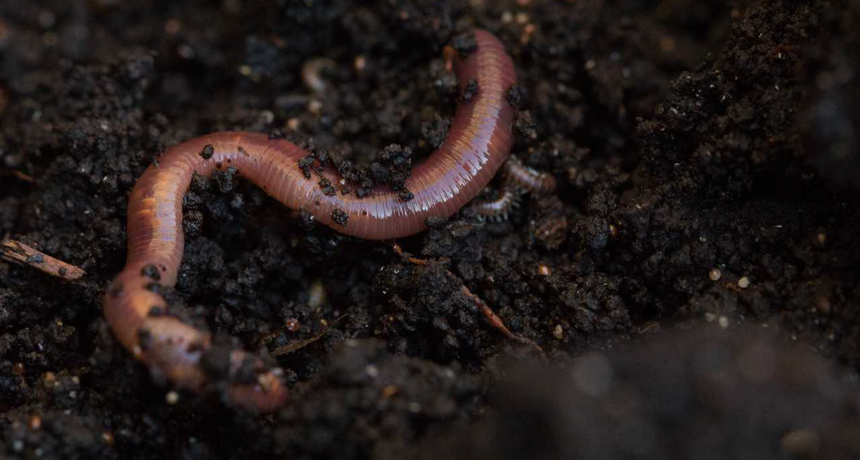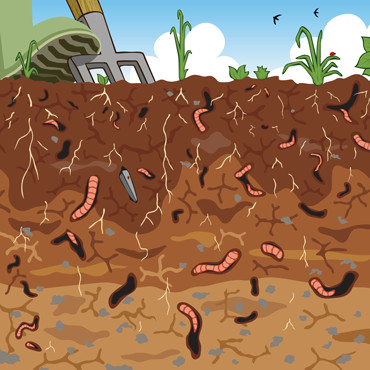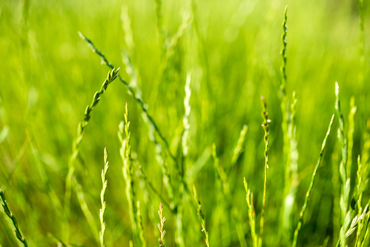Earthworms lose weight in soils polluted with microplastics
Plants were stunted, too, as scrawnier worms may offer fewer benefits to them and their soil

Earthworms help keep soil healthy. They digest plant matter, leaving nutrients for the soil. But in a new study, soil microplastics hurt worm growth and stunted plants.
Dan Brekke, Flickr (CC-BY-NC 2.0)
Microscopic bits of plastic have been showing up throughout the environment. Most measurements of it have been made in water. But this pollution can taint the air and soil, too. A new study finds that microplastics in soil can stunt the growth of earthworms. And that’s worrying, its authors note, because earthworms tend to help make soil good for growing plants.
“Soils are the foundation of the food chain,” says Bas Boots. He’s one of the study’s authors. Healthy soil, he notes, “supports plant growth, including food we eat.”
Earthworm poop also helps keep soil healthy. As worms burrow, they eat organic matter such as dead plants. Their poop — called castings — contains essential nutrients such as nitrogen and phosphorous. These nutrients help plants grow. Boots works at Anglia Ruskin University in Cambridge, England. As an ecologist, he studies how people affect soils. He and his team focused on earthworms exposed to microplastics. Worms create little tunnels as they move through the ground. These tunnels allow air and water to get to plant roots. Without worm tunnels, soil can dry out and become too compacted for plants to grow well.
The new study found that worms living in soil with microplastics lost weight. So did ryegrass, a popular grass used for lawns. When ryegrass was grown along with worms and microplastics, both it and the worms became stunted.
Boots’ team shared its findings September 11 in Environmental Science & Technology.
A broad range of pollutant sources
Microplastics are five millimeters (0.2 inch) or smaller. They often are released by the breakdown of water bottles, shopping bags or other plastic products. Clothing made from nylon fleece also can shed plastic fibers when it’s washed. Those fibers will go down the drain and into the environment. Even car tires and breaks can release microplastics.
Scientists have known since the 1970s that microplastics pollute the ocean. Only in the last 15 years or so, have scientists learned how microplastics enter waterways, including lakes and rivers. (From there, those plastic bits flow to the oceans.)
Recently, researchers have begun finding microplastics in the air and soil, too. For instance, a 2018 study found both such plastic bits polluting farmlands.
How do they get there? Plastic fibers and dust can settle out of the air. Sewage can contain microplastics. Farmers sometimes spread that treated sewage on farm fields as fertilizer. Many farmers also cover parts of their fields with plastic mulch to suppress weeds and to keep soils from quickly drying out.
“People even throw plastic [trash] on the ground — including cigarette butts,” notes Boots. That plastic litter breaks down over time into smaller and smaller bits, he points out.
Earthworms make good gardeners
Studies have shown that when there are microplastics in water, fish and shellfish will eat them. Similarly, the new study finds that when there are microplastics in soil, worms will eat them. So the researchers designed experiments to learn how that might affect the worms.

First, Boots’ group added one of three types of microplastics to pots of dirt. Some pots got bits of polyethylene (Pah-lee-ETH-eh-leen). This material is used to make plastic bottles and disposable bags. Another set of pots got a biodegradable plastic made from polylactic acid. A third set had microplastic clothing fibers mixed into the dirt. Boots says the amount of microplastics his team added was “relatively high, but not unrealistic for soils.” A fourth set of pots had dirt with no plastic pollution.
Next, the researchers dug up rosy-tipped earthworms. They collected them from grassy areas in Cambridge. These worms are common in the topsoil of temperate regions (latitudes between the subtropics and the poles). Such regions include most of the United States, Canada and Europe, as well as Central Asia, southern South America and southern Australia.
The researchers weighed each worm at the start of the tests. That way they could compare its weight before and after exposure to the plastic. But first, they had to get the worms to empty their guts. Otherwise, the starting weights would include undigested organic matter. Then the worms’ end weights wouldn’t be a true measure of their growth.
Fortunately, worms are basically digesting and pooping machines, explains Boots. “The earthworm will just go about its business and will produce casts, or worm poo, as if it was still in the soil,” he says. “Without any soil to eat, this will empty their guts.” So the researchers just had to wait until the worms’ pooping stopped.
As they waited, the researchers also had to guard against the worms running away. “Earthworms can be surprisingly fast,” he says. So they corralled the worms during this stage in high-rimmed beakers.
Worms weigh in

Now the worms were ready to be tested. Boots’ team put two worms in each pot of dirt. Next, they planted the pots with ryegrass seeds. Then they let the worms munch away for 30 days. Afterward, the worms had a second weigh-in. Those living in plastic-free dirt gained an average of 5.1 percent over the month.
In contrast, all worms living in dirt with microplastics lost weight. On average, they dropped 3.1 percent of their starting weight. (Worms that ate polyethylene-loaded dirt lost the most — an average of 5.6 percent.)
Turf grass growing with plastic also was stunted when compared to the grass growing in clean dirt. The researchers could not say whether the stunted grass was due to the smaller worms in their pot or to toxic effects of the plastic. “That’s because we did not have a set of pots . . . without any earthworms,” says Boots. “So there is more work for us to do.”
The researchers also don’t know why the worms lost weight, but they have some ideas. The microplastic particles might have irritated their guts. Or chemicals in the plastic might have interfered with the worm’s ability to pick up nutrients from the dirt.
Breaking down
The new study is one of the first to look at the effect of microplastics in soil, notes Hayley McIlwraith. She studies microplastics at the University of Toronto in Canada. The use of one biodegradable type, here, is particularly interesting, she says. Many people don’t realize that biodegradable plastics can be harmful, she says.
Made from plants, biodegradable plastic is designed to break down more quickly than the traditional plastic made from oil. But biodegradable plastic will break down more quickly than regular plastic only if it is exposed to high temperatures for weeks at a time. This tends to happen only in special compost bins. In the open environment, it doesn’t break down any faster than regular plastic, she points out.
In that sense, she argues, “Biodegradable microplastics are not much better for the environment than regular microplastics.”
Boots hopes his study will encourage other scientists to do more research on the effect of microplastics in soil. “Earthworms are only a small part of the animal community that lives in the soil,” he points out. “If they are affected by plastics pollution, who knows what else may happen with others?”







